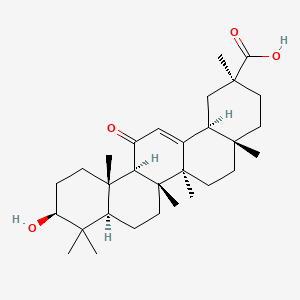| Authors | Title | Published | Journal | PubMed Link |
|---|---|---|---|---|
| Hung CF et al. | 18ß-glycyrrhetinic acid derivative promotes proliferation, migration and aquaporin-3 expression in human dermal fibroblasts. | 2017 | PLoS ONE | pmid:28813533 |
| Kitagawa H et al. | Pharmacokinetics of Active Components of Yokukansan, a Traditional Japanese Herbal Medicine after a Single Oral Administration to Healthy Japanese Volunteers: A Cross-Over, Randomized Study. | 2015 | PLoS ONE | pmid:26151135 |
| Ukil A et al. | Curative effect of 18β-glycyrrhetinic acid in experimental visceral leishmaniasis depends on phosphatase-dependent modulation of cellular MAP kinases. | 2011 | PLoS ONE | pmid:22194991 |
| Contreras JE et al. | Metabolic inhibition induces opening of unapposed connexin 43 gap junction hemichannels and reduces gap junctional communication in cortical astrocytes in culture. | 2002 | Proc. Natl. Acad. Sci. U.S.A. | pmid:11756680 |
| Lee KW and Ho WS | 18β-glycyrrhetinic acid induces UDP-glucuronosyltransferase in rats. | 2013 | Protein Pept. Lett. | pmid:24261979 |
| Zhou J et al. | 18β-glycyrrhetinic acid suppresses experimental autoimmune encephalomyelitis through inhibition of microglia activation and promotion of remyelination. | 2015 | Sci Rep | pmid:26329786 |
| Zhang W et al. | [Inhibitory effect of 18β-glycyrrhetinic acid on KCl- and PE-induced constriction of rat renal interlobar artery in vitro]. | 2014 | Sheng Li Xue Bao | pmid:24777410 |
| Ma KT et al. | [18β-glycyrrhetinic acid inhibits outward current of vascular smooth muscle cells of arterioles]. | 2011 | Sheng Li Xue Bao | pmid:22193450 |
| Ming J et al. | Regulatory effects of myoendothelial gap junction on vascular reactivity after hemorrhagic shock in rats. | 2009 | Shock | pmid:19077877 |
| Li S et al. | A novel transdermal fomulation of 18β-glycyrrhetic acid with lysine for improving bioavailability and efficacy. | 2012 | Skin Pharmacol Physiol | pmid:22832704 |
18alpha-glycyrrhetinic acid
18alpha-glycyrrhetinic acid is a lipid of Prenol Lipids (PR) class. 18alpha-glycyrrhetinic acid is associated with abnormalities such as Wiskott-Aldrich Syndrome. The involved functions are known as inhibitors, salivary gland development and branching morphogenesis.
Cross Reference
Introduction
To understand associated biological information of 18alpha-glycyrrhetinic acid, we collected biological information of abnormalities, associated pathways, cellular/molecular locations, biological functions, related genes/proteins, lipids and common seen animal/experimental models with organized paragraphs from literatures.
What diseases are associated with 18alpha-glycyrrhetinic acid?
18alpha-glycyrrhetinic acid is suspected in and other diseases in descending order of the highest number of associated sentences.
Related references are mostly published in these journals:
| Disease | Cross reference | Weighted score | Related literature |
|---|
No disease MeSH terms mapped to the current reference collection.
PubChem Associated disorders and diseases
What pathways are associated with 18alpha-glycyrrhetinic acid
There are no associated biomedical information in the current reference collection.
PubChem Biomolecular Interactions and Pathways
Link to PubChem Biomolecular Interactions and PathwaysWhat cellular locations are associated with 18alpha-glycyrrhetinic acid?
There are no associated biomedical information in the current reference collection.
What functions are associated with 18alpha-glycyrrhetinic acid?
Related references are published most in these journals:
| Function | Cross reference | Weighted score | Related literatures |
|---|
What lipids are associated with 18alpha-glycyrrhetinic acid?
There are no associated biomedical information in the current reference collection.
What genes are associated with 18alpha-glycyrrhetinic acid?
There are no associated biomedical information in the current reference collection.
What common seen animal models are associated with 18alpha-glycyrrhetinic acid?
There are no associated biomedical information in the current reference collection.
